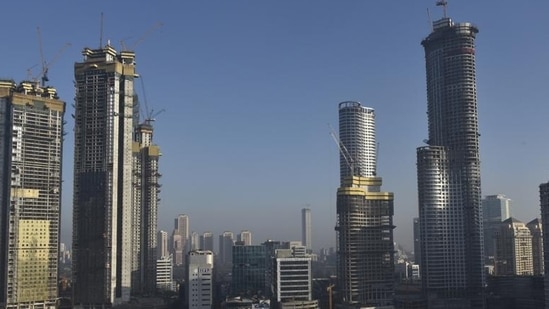[ad_1]
The Economic Survey said on July 22 that as of March 2024, over 1500 real estate companies were admitted into the insolvency resolution process under the IBC, accounting for 21% of the total admissions. One in four cases settled after admission was also from the real estate sector. Of the 891 corporate debtors resolved, 133 were real estate companies, forming 15% of the companies resolved.

It also noted that approximately 4.1 lakh stressed housing units, involving ₹4.1 lakh crore, are affected across the country as estimated by the Indian Banks’ Association and that “the legacy stalled real estate projects are a challenge.”
“The legacy stalled real estate projects is a challenge. Approximately 4.1 lakh stressed dwelling units, involving ₹4.1 lakh crore, are affected, as estimated by the Indian Banks’ Association (IBA),” it said.
The Ministry of Housing and Urban Affairs (MoHUA) established a committee to recommend solutions for completing stalled projects to address this issue. The committee identified the primary cause of stress as lack of financial viability, resulting in cost overruns and delays, the Economic Survey said.
Its recommendations include mandatory project registrations with RERA, execution of registration and sub-lease deeds for occupied units, ensuring possession of substantially completed projects, proposing state government rehabilitation packages for promoter-led resolutions, establishing frameworks for RERA and administrator-led project revivals, financing stalled projects, and utilising IBC as a last resort for resolving projects.
SWAMIH Fund delivered more than 32,000 homes
It also said that as of April 2024, the The Special Window for Affordable and Mid-Income Housing Fund (SWAMIH Fund) has delivered more than 32,000 homes and the delivery of 20,000 homes every year for the next three years is being targeted, it said.
Also Read: Economic Survey: Outlook for real estate sector encouraging but stalled projects a challenge
The impact of seamless resolutions and progress of cases under IBC and improvement in liquidity through the AIF is reflected in the healthy balance sheets of banks, thereby enhancing their ability to lend further, it said.
It also noted that bank defaults worth ₹10.2 lakh crore have been settled since 2016 at the pre-admission stage of insolvency.
The Economic Survey mentioned that the real estate sector has witnessed a “robust recovery” after two challenging years of pandemic-induced lockdowns and economic instability. The survey noted that the COVID pandemic has shifted homebuyers’ preferences toward larger, sustainable spaces with additional amenities, driven by remote and hybrid working trends.
Number of cases resolved through the consumer redressal route minimal
The Economic Survey noted that before 2016, the only remedy available for homebuyers whose housing projects were stalled for various reasons was through the Consumer Forums established under the Consumer Protection Act of 1986. In FY24, over 5,50027 cases were filed with the National Consumer Dispute Redressal Commission, and almost 21% were related to the housing sector.
However, the number of cases resolved through the consumer redressal route has been minimal.
RERA and IBC
The year 2016 saw the enactment of the Real Estate (Regulation and Development) Act 2016 (RERA Act). This provided a dedicated grievance redressal mechanism to the aggrieved homebuyers and a means to rein in errant real estate contractors and companies.
Subsequent enactment of the IBC in the same year opened another channel and has been the most favoured among the three available remedies. Insolvency resolution of real estate companies posed a unique set of challenges for the standardised corporate insolvency process, it said
Real estate companies have multiple projects spread across geographies, projects at different stages of construction, and diversified business models. The large number of homebuyers across these projects meant claims from thousands of homebuyers who needed to be included in the process, it said.
The judiciary, the Government, and the market have recognised these difficulties and moved in cohesive steps to improve outcomes for these projects. The availability of two new remedial routes led to discord and friction in the system, it observed.
The Insolvency Law Committee, in its March 2018 report took cognisance of the peculiarity of the real estate sector. It recommended that the amount raised from homebuyers be considered financial debt as it formed a significant contribution to finances raised and had the commercial effect of borrowing. This led to substantial changes in the CIRP by making homebuyers a distinguished class of creditors and a part of the Committee of Creditors, enabling their direct participation in decision-making. A system to organise and derive decisions, through consensus of majority voting of the thousands of homebuyers, was also worked out to introduce insolvency professionals as authorised representatives, it said.
Further amendments enabled insolvency to be initiated by a joint application of not less than 100 allottees or not less than 10% of the total number of allottees under the same project, ensuring that frivolous applications are not filed.
As clarity emerged on the use of IBC as a remedy for homebuyers, it was also laid out that resolution plans approved for real estate projects should necessarily be compliant with the RERA Act, thereby restoring primacy to the sectoral law and the sectoral regulator in its domain for optimal oversight of the sector. By way of innovation in economic law, the judiciary paved the way for solutions in resolving real estate corporate debtors. As a class of creditors, it enabled homebuyers to act as resolution applicants, it observed.
It approved what was termed a “reverse CIRP”, where the corporate debtor could take measures to complete the project even as the resolution process was underway. The judiciary has allowed project-specific resolution plans, targeting the affected project alone under the same corporate debtor. This measure relieved the corporate debtors and allottees of different projects, and the market has responded positively
IBC a boon for homebuyers
In the case of Value Infracon India Private Limited, the resolution process yielded creditors 98% of the claim value and 189% of the asset’s liquidation value. In the cases of Ashiana Landcraft Realty Private Limited and Anudan Properties Private Limited, the resolutions yielded around 2.5 times the liquidation value of the assets. Large corporate debtors in the sector, like Jaypee Infratech Limited, have been resolved with a recovery of 88% for creditors, and assets have been acquired at over 114% of liquidation value.
According to Piyush Agrawal, Partner, AQUILAW, IBC establishes a necessary and structured process for the insolvency resolution or liquidation of companies.
“The significant number of settlements occurring at the pre-admission stage, driven by the fear of loss of control, highlights the importance of the IBC in maintaining economic stability and its robustness in building confidence among creditors and improving the business ecosystem. However, the issue of companies becoming defunct, before the conclusion of the process indicates the need for amelioration of the Code to prevent inordinate delays and to avoid the erosion of assets of companies undergoing insolvency,” he said.
[ad_2]
Source link






Join The Discussion